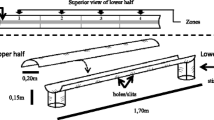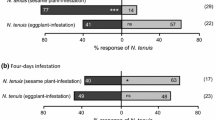Abstract
Wild populations of house flies were inhibited from ovipositing into poultry manure containing larvae of the black soldier fly,Hermetia illucens (L.). A laboratory strain of house fly responded differently, readily ovipositing into manure with lower densities of soldier fly larvae, but avoiding the higher densities tested. The amount of timeH. illucens larvae occupy the manure prior to an oviposition test influences ovipositional responses of house flies. Manure conditioned byH. illucens larvae for 4–5 days did not significantly inhibit house fly oviposition. We suggest that some type of interspecific chemical communication (allomone) is present.
Similar content being viewed by others
References
Axtell, C.R., andEdwards, T.D. 1970.Hermetia illucens control in poultry manure by larviciding.J. Econ. Entomol. 63(6):1786–1787.
Birch, M.C., Svihra, P., Paine, T.D., andMiller, J.C. 1980. Influence of chemically mediated behavior on host tree colonization by four cohabiting species of bark beetles.J. Chem. Ecol. 6:395–414.
Bryant, E.H., andHall, A.E. 1975. The role of medium conditioning in the population dynamics of the housefly.Res. Popul. Ecol. 16:188–197.
Byers, J.A., andWood, D.L. 1980. Interspecific inhibition of the response of the bark beetles,Dendroctonus brevicomis andIps paraconfusus, to their pheromones in the field.J. Chem. Ecol. 6:149–164.
Corbet, S.A. 1971. Mandibular gland secretion of larvae of the flour moth,Anagasta kuehniella, contains an epideictic pheromone and elicits oviposition movements in a hymenopteran parasite.Nature 232:481–484.
Dunn, L.H. 1916.Hermetia illucens breeding in a human cadaver.Entomol. News 27:59–61.
Furman, D.P., Young, R.D., andCatts, E.P. 1959.Hermetia illucens (Linnaeus) as a factor in the natural control ofMusca domestica Linnaeus.J. Econ. Entomol. 52:917–921.
Gonzalez, J.V., Young, W.R., andGenel, M.R. 1963. Reducción de la población de mosca domestica en gallinaza por la mosca soldado en el Trópico.Agric. Tec. Mex. 2(2):53–57.
Ikeshoji, T., andMulla, M.S. 1970. Overcrowding factors of mosquito larvae.J. Econ. Entomol. 63:90–96.
Kilpatrick, J.W., andSchoof, H.F. 1959. Interrelationship of water andHermetia illucens breeding toMusca domestica production in human excrement.Am. J. Trop. Med. Hyg. 8:596–602.
Oshima, K., Honda, H., andYamamoto, I. 1973. Isolation of an oviposition marker from Azuki bean weevil,Callosobruchus chinensis.Agric. Biol. Chem. 37:2679–2680.
Prokopy, R.J. 1972. Evidence for marking pheromone deterring repeated oviposition in apple maggot flies.Environ. Entomol. 1:326–332.
Prokopy, R.J. 1981. Epideictic pheromones that influence spacing patterns of phytophagous insects, pp. 181–213,in D.A. Nordlind, R.L. Jones, and W.J. Lewis (eds.). Semiochemicals: Their Role in Pest Control. John Wiley & Sons, New York.
Renwick, J.A., andRadke, C.D. 1980. An oviposition deterrent associated with frass from feeding larvae of the cabbage looper,Trichoplusia ni.Environ. Entomol. 9:318–320.
Sheppard, D.C. 1983. House fly and lesser house fly control utilizing the black soldier fly in manure management systems for caged laying hens.Environ. Entomol. 12:1439–1442.
Tingle, F.C., Mitchell, E.R., andCopeland, W.W. 1975. The soldier fly,Hermetia illucens, in poultry houses in north central Florida.J. Ga. Entomol. 10:179–183.
Author information
Authors and Affiliations
Additional information
Diptera: Stratiomyidae.
Portion of an MS thesis by S.W.B.
Research partially supported by State and Hatch funds.
Rights and permissions
About this article
Cite this article
Bradley, S.W., Sheppard, D.C. House fly oviposition inhibition by larvae ofHermetia illucens, the black soldier fly. J Chem Ecol 10, 853–859 (1984). https://doi.org/10.1007/BF00987968
Received:
Revised:
Issue Date:
DOI: https://doi.org/10.1007/BF00987968




